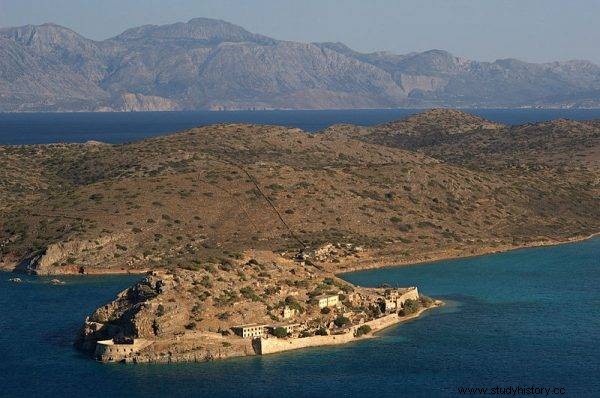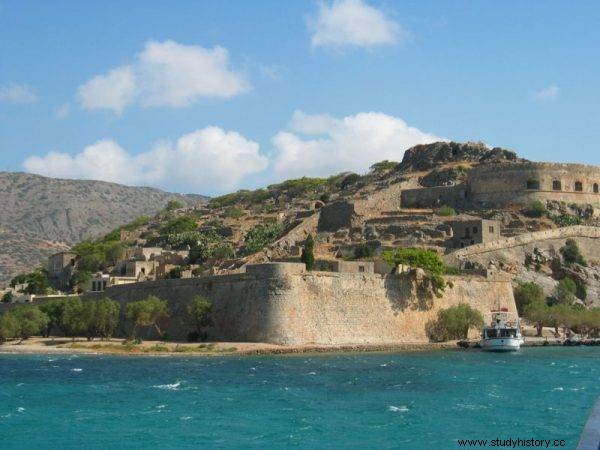On this small island, from 1903 until 1957, one of the last closed leper colonies in Europe operated. Officially, a substitute for a normal life was created for them. The truth, however, was terrifying - that Spinalonga had no escape, and its forced inhabitants were disappearing from their documents, doomed to a slow death. Their children were taken away, they were excluded from society. Families even rejected them when an effective drug was invented.
Crete, Neapoli, summer 2018
The old man stares stubbornly at me. She has pale blue eyes and gray curly hair. This man can help me reach the people I want to meet, so I was told in the Lassithi Tourism Department when I asked about the lepers in Spinalonga. On this small island in the north-eastern outskirts of Crete, one of the last leprosy colonies in Europe operated from 1903 until 1957.
The Forgotten Leper Island
The man sitting in front of me is Maurice Born, a Swiss ethnologist who has been working on the subject of Spinalonga since 1968. Maurice knows its inhabitants and I have been looking for an opportunity to meet them since I first came across Spinalonga in 2017 while on a vacation in Crete.
The organizer of that vacation trip planned trips around the area for each day, but I only went on this one, to Spinalonga. Not because I love seeing post-Venetian fortresses. Rather, I was due to the three-hour ferry trip in total - to Spinalonga and back - on the Mirabello Bay, famous for its beautiful views, on which lies an island with the remains of a former leprosarium.
It is the largest gulf of Greece and the fifth largest in the entire Mediterranean. A few years ago, the bay seemed much more interesting to me than an abandoned leprosarium or the remains of former fortresses . Spinalonga herself was rather "by the way."

The text is an excerpt from Małgorzata Gołota's book "Spinalonga Wyspa leperskich", which has just been published by the Agora publishing house.
The cure for death
The lepers from Spinalonga lived a normal life in the leprosarium. There were cafes called kafenions by the Cretans, a hairdressing salon, weddings were held and children were born who later went to school on the island - says the tourist guide when I visit the island with a trip.
There is so little tragedy in this story that it is hard to believe. The woman continues:
The islanders celebrated holidays and participated in the life of the local church. People with leprosy recreated the social and social life they had known before the closure in Spinalonga. Leprosarium patients remained in isolation until 1957, when the colony was liquidated.
This was possible thanks to the invention of an effective cure for leprosy - it was a drug known as diasone. Longevity was a side effect of using this drug. Imagine that today there are eight people who remember living in the leper colony in Spinalonga.

On May 30, 1903, a decision was made to transform Spinalonga into an island of lepers.
After returning to the hotel, I search the Internet for information about the former inhabitants of the leprosarium, but I do not find any solid report about Spinalonga. Most of the results are perfunctory information straight from tourist catalogs. The search effect in Greek is not much better. On the Greek Wikipedia under the heading "Spinalonga" there are also only brief notes:
Spinalonga is a small island that closes to the north Elounda Bay in the Mirabello Province of Lasithi Prefecture in Crete. It was perfectly fortified by the Venetians - both in terms of construction and architecture, and in terms of the aesthetics of the entire landscape, which still retains its beauty. (…)
Blurred tracks
On May 30, 1903, a decision was made to transform Spinalonga into an island of lepers, and the first patients were transferred here in 1904 (...). The leprosarium was finally closed in 1957 , after the development of an effective leprosy cure.
Several articles in Greek were written about the island, the romantic novel The Island British writer Victoria Hislop, whose action takes place on Spinalonga - available for purchase online in several languages, including Polish - as well as a short, interesting text on the BBC website.
Elizabeth Warkentin briefly describes the mystery surrounding the island related to the leper colony, and in an interview with the author, Maurice Born speaks as an expert. He addresses the words to the journalist:
You see, the story of Spinalonga is a story of a huge lie. After the colony was closed, the Greek government, wishing to obliterate all traces of the leprosarium's existence, burned all the files relating to it. Everything was supposed to look like Spinalonga didn't exist at all.
The Warkentin text does not explain why the Greek government would cover its tracks and pretend that the whole story did not happen. Neither is there any statement by any of the former residents of the leprosarium.
" I went to jail without committing any crime"
I come across Borna's name several times in subsequent materials. It is he - together with Marianne Gabriel - who is the translator and author of the introduction to the memoirs of a certain Epaminondas Remoundakis Vies et morts d'un Crétois lépreux translated from Greek and published in French by Anacharsis in 2015. Born also writes the Jean-Daniel Pollet film L'Ordre - 1973 short documentary still available on YouTube.
"L'Ordre" means order in French, something that is imposed, fixed, unchanging. Rules to be followed.
At sunset, the island looks beautiful. The sunsets are really great here. It is the shots shot at this time that make up the first frames of L'Ordre .

The lepers of Spinalonga led normal lives in the leprosarium.
The next ones also affect emotions. Perhaps the most powerful sound accompanying the raising of the barrier. The barrier is positioned right behind the gate, above which you can see the barbed wire. This is the entrance gate to the leper station at Agia Varvara Hospital in Athens. The sick were sent here from Spinalonga when the island leprosarium was closed in 1957. And this is him, Epaminondas Remoundakis. He stares straight ahead with eyes that can see nothing anymore. She corrects her hair with fingerless hands. He takes a deep breath and starts saying:
It has been thirty-six years since I was imprisoned, although I did not commit any crime. Over the years many people have spoken to me, to us. Some of them took pictures of us, others wanted to write about us, others made films. All these people made promises to us that they didn't keep.
They cheated on us. None of these people gave the world what we wanted. She didn't tell the truth. We don't want to be hated. All we once needed and need today is love. We would like to be loved and accepted as people who have suffered a misfortune.
We don't want to be a phenomenon, a different species of human. We have the same dreams as you. Therefore, do not include us in a different, separate world. Will you as foreigners be different? Will you tell the truth or will you decorate your recordings with lies?
Condemned to death
In the film, Remoundakis is almost sixty years old. Although he is already very weakened by the disease, he speaks clearly, logically, in a loud voice. Blind eyes look straight at the camera.
An open grave. It's an island again. This is a cemetery that was destroyed by tourists. There is no coffin, there is an incomplete skeleton. The shoes on the bones were damaged. Epaminondas, and then this woman. Blind, with her hand she tries to find something in front of her. She is wearing only a nightgown and her hair is disheveled. A leper.

For lepers, Spinalonga has become a prison
Change of the frame. A man in dark glasses looks at me, his face slightly marked by the disease. Buildings. Island. And Remoundakis again:
On Spinalonga, the creature spirit did not exist. Anyone who has ever entered the island has entered it with the prospect of death, without hope. That's why we had ice souls. Tears and separation have happened every day in our lives.
There are ampoules on the grass. Heaps of empty ampoules scattered across the island long ago. Evidence of a disease that has isolated the islanders from the rest of the world. Remoundakis says again:
So that today you can feel exactly what we once felt and what was happening on the island then, let me tell you this: on Spinalonga a huge wall of slander has been erected against us . All this so that other, healthy, perceive us as different creatures, strange creatures. So much so that when businessman Papastratos offered us a telephone in 1938, the island administration did everything not to install it on Spinalonga.
The phone would release our locked voice on the island, full of irritation at all the injustices committed against us. This life was suffering and yet I myself say today:it was better to live in Spinalonga than to live here and see this regrettable state lying to the people we love.
Stop while time - Remoundakis spells. - Stop, because you're headed straight for a catastrophe. Sorry. I am telling you this sincerely as representatives of your community, your world. Your decadence, indifference and insolence will eventually lead you to disaster.
L’Ordre it's over half a century of history leprosarium closed in 44 minutes.
Source:
The text is an excerpt from Małgorzata Gołota's book "Spinalonga Wyspa leperskich", which has just been published by the Agora publishing house.
